That Fit Friend is supported by its readers. I [Jake Boly] run this site myself and buy the gear I review. If you purchase through my site, I may earn commissions on sales, read more here!
Table of Contents+
To readers: This list is built for WEIGHTLIFTING shoes. These are specific types of shoes. Peep this article for general gym shoes for the act of WEIGHT LIFTING.
If you’re new to weightlifting shoes, these shoes are designed to promote your performance for squats and weightlifting (snatch and clean & jerk), and they can be useful for quad-focused exercises.
- Purposely elevated heel. Heel heights, typically built with a TPU or high-density EVA, will range from .5 inches to 1 inch in height. This is designed to promote sport and squat performance. Read more here about how it changes performance.
- Additional midfoot security. Weightlifting shoes will have additional straps for midfoot security. Generally speaking, you’ll see this in the form of a single or double strap on the midfoot.
- Dense rubber outsoles. Every weightlifting shoe will have a dense rubber outsole (outsole = bottom material of the shoe) to promote grip and stability.
In fact, I typically tell clients who ask to get a good training shoe first, then worry about adding a weightlifting shoe to their rotation as their training gets more serious and specific, but if you are on the market — then you’ve come to the right place.
Weightlifting Shoes Buying Guide
- What to Buy for MEN: Reebok Legacy Lifter 3 ($160-220)
- What to Buy for WOMEN: Adidas Adipower 3 ($170-220)
- Great for BUDGET SHOPPERS: Reebok Lifter PR 3 ($80-120)
- My Go-To Pick for CROSSFIT: Inov-8 Fastlift Power G 380 ($180-220)
- My Suggestion for WIDE FEET: TYR L-2 Lifter ($225)
- My Suggestion for FLAT FEET: NOBULL Canvas Lifter ($150)
- Good Pick for BEGINNERS: Adidas Powerlift 5 ($80-120)
- My Suggestion for NARROW FEET: Nike Romaleos 4 ($200)



That Fit Friend is an indepedent resource run solely by me Jake. I buy the shoes I review and there’s no outside influence from retailers in my rankings.
My Favorite Pick for Men | Reebok Legacy Lifter 3
Specs Overview
- Max Weight Squatted In These (thus far!): 415 lb back squat, 365 lb front squat
- Removable Insole: Yes
- Sizing: True to size (neutral width)
- Read: My Review

Who Should Buy the Legacy Lifter 3
- Athletes who want a stable shoe for squats and weightlifting.
- Lifters that like heavier and more rigid shoes for squatting.
- Anyone who wants a shoe that will last a while that is consistent across the board.
Who Shouldn’t Buy the Legacy Lifter 3
- Athletes who hate heavier shoes for training.
- Lifters with wider feet (3E or wider stay away).
The Reebok Legacy Lifter 3 is a really strong option for the squat and weightlifting-focused guy. This model delivers consistent performance in a variety of training settings and is a good “all-in-one” style weightlifting shoe.
This model features a stable TPU heel with an effective heel height of 22mm or .86 inches. When it comes to moving heavy weight in squats, cleans, and snatches, the Reebok Legacy Lifter 3 delivers a strong performance and is similar to the Legacy Lifter 2.




The adjustable thicker midfoot strap on this model also does a good job of promoting overall foot security. This strap system feels durable and much less clunky compared to the original Reebok Legacy Lifter and the Pump system can be useful for promoting security.
The toe box in this model has a nice level of maneuverability and I’d describe its fit as neutral. It’s not going to be the best option for wide feet, but for most foot anatomies, the Legacy Lifter 3 delivers a good fit.
The Bottom Line: The Legacy Lifter is consistent. If you’re a guy needing a shoe for casual squat sessions or snatches and clean & jerks, this shoe doesn’t disappoint and its stability and lockdown are solid.
Community’s Pick for Women | Adidas Adipower 3
Specs Overview
- Removable Insole: Yes
- Sizing: True to size (neutral width)
- Read: My Review

Who Should Buy the Adipower 3
- Athletes who want a consistent shoe for doing squats and weightlifting.
- Lifters with narrow to medium foot widths.
- Anyone needing that “first” weightlifting shoe that will last them a while.
Who Shouldn’t Buy the Adipower 3
- Athletes who want more flexible toe boxes that have more malleability.
- Lifters with wider feet who need more toe box room.
The Adidas Adipower 3 is a great option that usually works great for women’s foot anatomies. This weightlifting shoe delivers a strong performance in the gym for a variety of training contexts.
This shoe’s ripstop upper construction does a good job with durability and it delivers one of the better-looking appearances of weightlifting shoes. The TPU heel in this model is stable and feels relatively lightweight.




The midfoot strap is also well-built, and its construction feels similar to that of the original Adidas Adipower. For squats, weightlifting, and recreational lifting, the Adidas Adipower 3 does a good job.
One core reason why this model made the top of this list, though, is due to its last construction. The Adipower 3 has a neutral and narrower width so it has an “athletic” fit to it when training. I included wider options below if you need more width.
The Bottom Line: The Adipower 3 is a nice continuation for this shoe line. It’s not as good as the GOATED original shoe, but it gets the job done for most and its narrower shape tends to work well with women’s foot anatomies.
Good Budget Lifting Shoes | Reebok Lifter PR 3
Specs Overview
- Max Weight Squatted In These (thus far!): 395 lb back squat, 475 lb Hatfield squat
- Removable Insole: Yes
- Sizing: True to size (neutral width)
- Read: My Review

Who Should Buy the Lifter PR 3
- Beginners who want a consistent shoe that will last a while.
- Athletes that like lower heels for squatting and training.
- Recreational lifters who are on the fence about what to buy — seriously, just grab these for a good price.
Who Shouldn’t Buy the Lifter PR 3
- Athletes who like more “snappy” midsoles and heels when catching weight.
- Lifters with 3E or wider feet.
The Reebok Lifter PR 3 is a tried and true model with a good price point. It’s tough to fault the construction and performance of the Reebok Lifter PR 3 for its $100 or lower price point.
Additionally, you can often find this model marked down with multiple colorways on sale, so more than likely, you’ll be able to find them for less than $100 which is even better.




This shoe delivers a stable high-density EVA midsole and its midfoot strap has a nice level of security. Plus, unlike other budget weightlifting shoes that you’ll find on Amazon, both of these construction features feel pretty durable and well-constructed.
The textile upper on this model breathes pretty well and it’s a good “all-in-one” style weightlifting shoe for someone wanting to save. Whether you’re new to weightlifting shoes or you want to save money, this is a good consistent model to explore.
The Bottom Line: If you’re wanting to spend around $100 on weightlifting shoes then it’s tough to beat the Lifter PR 3. These shoe has great stability, lockdown, and tick all of the boxes you want for a fair price.
My Pick for CrossFit WODs | Inov-8 Fastlift Power G 380
Specs Overview
- Max Weight Squatted In These (thus far!): 385 lb back squat, 430 lb Hatfield squat
- Removable Insole: Yes
- Sizing: True to size (neutral width)
- Read: My Review

Who Should Buy the Fastlift Power G 380
- Lifters who want a shoe with a flexible toe box with a lot of ground feel.
- Athletes who want a good weightlifting shoe for everything.
- Anyone who likes lightweight shoes and actively seeks that out when buying.
Who Shouldn’t Buy the Fastlift Power G 380
- Lifters that enjoy heavier shoes with more built-out outsoles and uppers.
- Athletes who like lower heel heights
There’s a lot to like about the Power G 380, especially for lifter who loves a more flexible toe box. I find that this model works great for functional fitness due to blend of features that other heavier models just don’t deliver on.
First, this shoe features a stable and lightweight graphene-infused power heel. Compared to other weightlifting shoes, this model has a lighter weight which is great for more dynamic training sessions.




Second, the ripstop upper and graphene rubber outsole are durable and the midfoot strap delivers a solid level of security. From a durability and security standpoint, this shoe does a really good job.
Third and lastly, this model’s toe box has a lot more maneuverability compared to other weightlifting shoes. This is a big reason why this model is taking my top pick here because blocky and stiff toe boxes can feel rough during CrossFit workouts.
The Bottom Line: This model is one of, if not the most unique weightlifting shoe on this list. Its lightweight build and flexibility set it apart from the clunkier and heavier models listed.
Suggestion for Wide Feet | TYR L-2 Lifter
Specs Overview
- Max Weight Squatted In These (thus far!): 420 lb back squat, 315 lb front squat
- Removable Insole: Yes
- Sizing: True to size for most. Size up a half-size for wide feet.
- Read: My Review
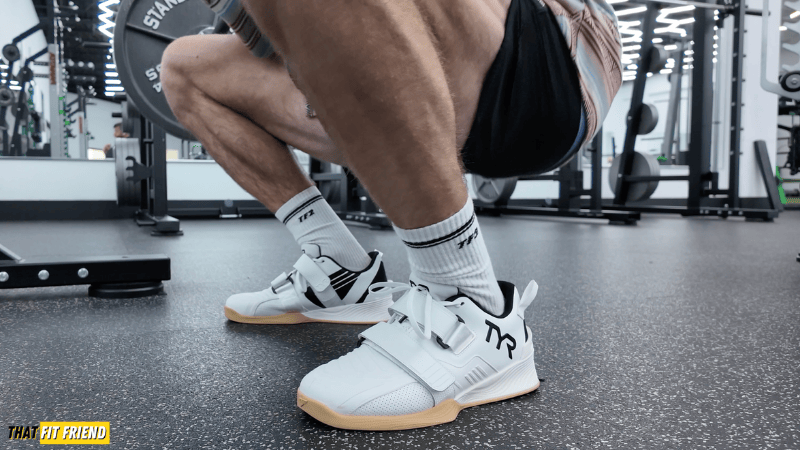
Who Should Buy the L-2 Lifter
- Lifters who want a shoe with a wider toe box.
- Athletes who like heavier shoes that feel anchored when training.
- Anyone who likes squatting with a slightly higher heel.
Who Shouldn’t Buy the L-2 Lifter
- Lifters with narrow feet in the toe box area.
- Athletes who also plan to use these in more versatile contexts outside of powerlifting (like leaving them on throughout CrossFit WODs, this won’t be applicable for most).
The TYR L-2 Lifter is my favorite option for wide feet, and note, I have E-width feet. In the context of toe box width in weightlifting shoes, there isn’t a model that competes with the TYR L-2 Lifter.
This model’s main claim to fame is its width, and I think most lifters will enjoy how much they can splay their toes in this model. Regarding width, I would compare the L-2’s toe box shape and construction to a Xero Shoes Prio (a popular barefoot shoe).
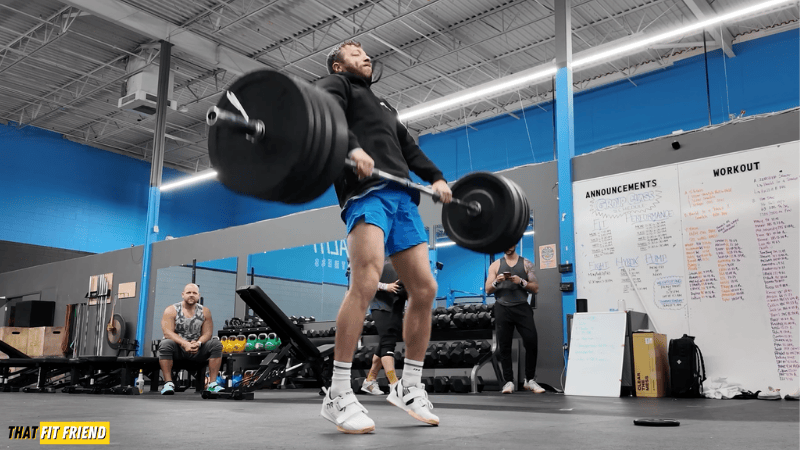
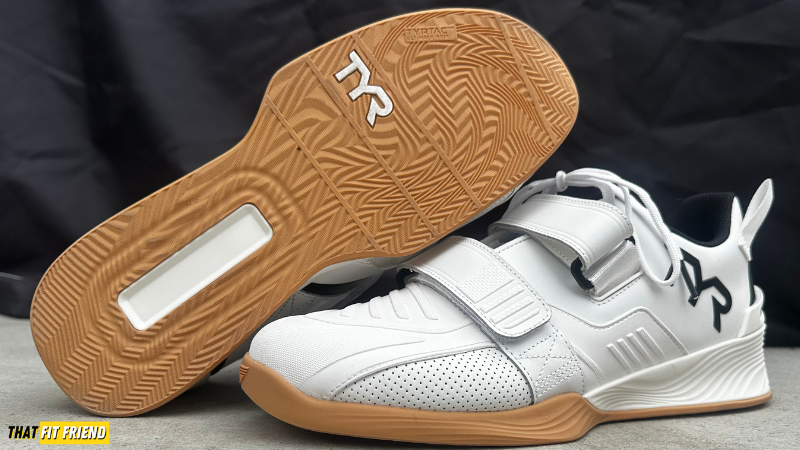
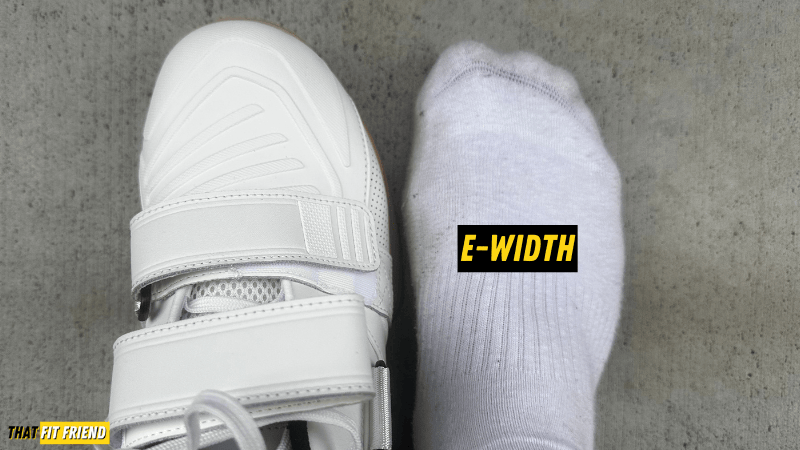
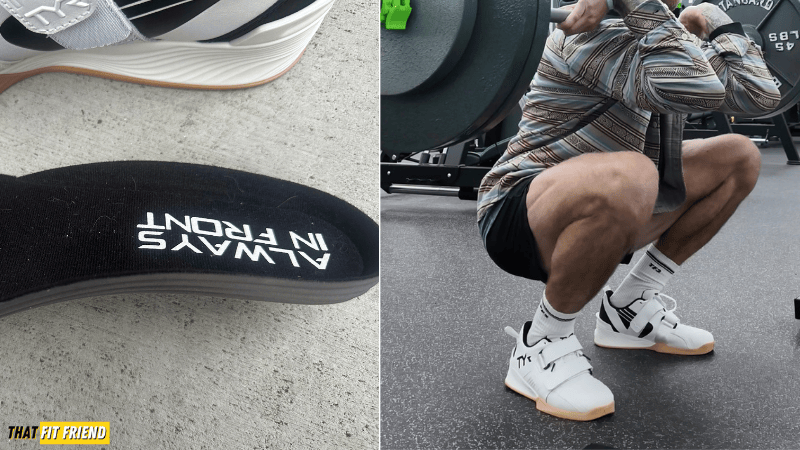
Outside of being wider than other weightlifting shoes on the market, the TYR L-2 Lifter also delivers a strong performance in the gym. This model is plenty stable for heavy squats and gave me no issues when squatting up to 420 lbs in them.
Additionally, the dual straps provide this shoe’s midfoot a nice level of security, so they should work pretty well for recreational lifting, weightlifting, and even functional fitness workouts.
The Bottom Line: The TYR L-2 Lifter is still the widest option on the market, even if some feel like it’s snugger than the prior model. Pro tip: If you need more width, go up a half-size and take the insole out. It will give you a more spacious toe box fit.
Suggestion for Flat Feet | NOBULL Canvas Lifter
Specs Overview
- Max Weight Squatted In These (thus far!): 375 lb back squat, 335 lb front squat
- Removable Insole: Yes
- Sizing: True to size (neutral width)
- Read: My Review

Who Should Buy the Canvas Lifter
- Lifters who like wider-fitting shoes with less arch.
- Beginners needing a first weightlifting shoe.
- Athletes who want a quality feeling shoe for a decent price.
Who Shouldn’t Buy the Canvas Lifter
- Lifters that struggle with “being forward” in their pulls.
- Athletes who like flatter feeling shoes.
The NOBULL Canvas Lifter is a strong option for flat feet. This model has steadily grown on me regarding its performance and I think it’s a decent option for flatter feet.
The NOBULL Canvas Lifter is designed to have a more anatomical-shaped toe box and it doesn’t have an aggressive arch or midfoot like some of the other lifting shoes in this list.




Regarding performance, the NOBULL Canvas Lifter is pretty standard across the board. This shoe features a high-density EVA foam for its midsole and heel so compression shouldn’t be an issue in this shoe when moving weight.
Additionally, the single midfoot strap and canvas upper do a pretty good job of promoting overall security when training. I also like that this model costs around $149.99 which is a lower price point than most premium weightlifting shoes.
The Bottom Line: The Canvas Lifter is a decent option for flatter feet with its wider construction. It’s also WAY better than the other NOBULL Lifter that costs way more. My advice, go cheaper and get the wider option.
Good Option for Beginners | Adidas Powerlift 5
Specs Overview
- Max Weight Squatted In These (thus far!): 405 lb back squat, 355 lb front squat
- Removable Insole: Yes
- Sizing: True to size (medium width)
- Read: My Review
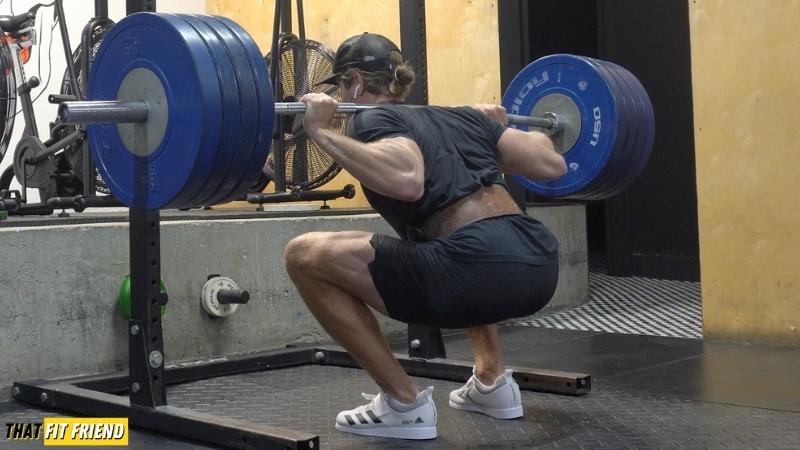
Who Should Buy the Powerlift 5
- Beginners wanting a first pair of weightlifting shoes.
- Athletes with narrower feet.
- Lifters who like lower heel heights.
Who Shouldn’t Buy the Powerlift 5
- Anyone with wide feet.
- Weightlifing athletes who want higher heels.
- Lifters who like flexible toe boxes.
The Adidas Powerlift 5 is my favorite beginner-friendly lifting shoe. This model delivers a strong performance in the gym and has a price point that sits around $120.
This model features a high-density EVA foam heel and midsole, which is plenty stable for most beginners getting into weightlifting shoes. The midfoot strap on this model also does a good job supporting foot security when training.




The flexible mesh and canvas upper also do a good job of supporting this shoe’s breathability. I also like the rubber outsole and the level of tread you get with the Adidas Powerlift 5 on rubber gym floors, wooden platforms, and machines.
Another reason why I like the Adidas Powerlift 5 for beginners is their overall versatility. They do a good job for a variety of training contexts so if you’re trying to figure out the “when to wear” for weightlifting shoes and your training, they’re a good pick.
The Bottom Line: The Powerlift 5 is tried and true. They last a while, provide plenty of stability, and have a nice price point. I’d also suggest looking into the Powerlift 3 for beginners.
Top Pick Narrow Feet | Nike Romaleos 4
Specs Overview
- Max Weight Squatted In These (thus far!): 405 lb back squat, 355 lb front squat
- Removable Insole: Yes
- Sizing: True to size (neutral/narrow width)
- Read: My Review

Who Should Buy the Romaleos 4
- Athletes who have narrower feet.
- Lifters that like snug-fitting toe boxes and shoes with midfoot support.
- Lifters who like heavier shoes with flatter feeling platforms.
Who Shouldn’t Buy the Romaleos 4
- Anyone with wide feet.
- Athletes with flatter feet who despite arch in their shoes.
The Nike Romaleos 4 is a consistent and strong pick for lifters with narrow feet. Compared to other weightlifting shoes, this model does a good job for narrow feet for two specific reasons.
First, the fit of this model is what I would describe as neutral with a bias towards being more narrow. Second, the upper volume in this shoe is pretty low so it gives you a snug fit through the midfoot and toe box.




If you often find that you’re sliding around in weightlifting shoes or as though you can’t get them tight enough, I don’t think you’ll have these issues with the Nike Romaleos 4.
The Romaleos 4’s TPU heel provides a nice solid base to lift on and this shoe’s dual strap system provides a nice level of midfoot security. For squats, weightlifting, and recreational lifting, the Nike Romaleos 4 does a good job.
How Should Your Weightlifting Shoes Fit?
For weightlifting shoes, I always suggest having about a half inch or a thumb’s width of space at the end of your toe box. This will help prevent them feeling too cramped when squatting and catching weight.
This is usually a good amount to prevent heel slip as well. Keep in mind, though, that this can vary due to a shoe’s shape, your foot anatomy, and preferences.
If you have questions about sizing for a specific shoe, drop a comment below and let me know what your shoe size and what you currently wear for training/weightlifting shoes.

Before investing in new weightlifting shoes, I’d highly suggest making sure the shoe aligns with your foot anatomy. Some shoes will have different upper volumes and widths, which will make them better or worse for your individual needs.
My advice is to always look at reviews on a shoe’s product page for feedback from others and to cross-reference with other long-form reviews. You can also always reach out to me if you have additional weightlifting shoe questions.
Can Beginners Wear Lifting Shoes?
Absolutely. There is no set rule for when you can wear lifting shoes for training and a beginner can wear these shoes to promote their performance with squats, clean & jerks, and snatches.
In my coaching opinion, lifting shoes can be great tools to have on hand so you can rotate your footwear based on your training needs. For example, if you like squatting with an elevated heel versus in flat shoes, then they can be a great supportive tool for your training.
Plus, you can then rotate your shoes based on what you find helps you perform the best based on the workout you’re doing. This is a strategy that I and a lot of lifters use when chasing specific performance and lift-focused goals.

On top of this, if you find yourself wanting heel elevation for your squats, then a weightlifting shoe is a much better option than using a plate under the heel as a weightlifting shoe’s sole will give your foot more surface area which can then, in turn, can increase your stability and balance.
The takeaway point here is that beginners can certainly rock lifting shoes and I think it can be counterproductive to “wait for the right time” to invest in a good pair. Think of weightlifting shoes as tools, and you want the right tools for certain types of jobs.
Coaching Tip: If you’re brand new to weightlifting shoes, I’d suggest wearing them for training sessions where you’re working on sub-maximal loads to get used to this style of footwear as opposed to going super heavy right away.
Will Weightlifting Shoes Help My Squat?
Weightlifting shoes can be useful tools for promoting stronger squat performance. If you’re investing in your first pair of weightlifting shoes and you’ve been training in flat shoes like Vans, then I’d suggest acclimating to this style of footwear slowly.
For example, when you go from a flat shoe to a heel-elevated shoe it’s normal to see your form also change in certain lifts. A weightlifting shoe’s elevated heel will change your foot’s position, which will then shift your ankle, knee, hip, and torso mechanics.

In simplistic terms, a shoe’s elevated heel will typically allow you to feel like you can more comfortably track the knees over the toes while achieving more squat depth and maintaining an upright torso.
Weightlifting shoes can help promote better squat mechanics because they can help you better balance the barbell over the midfoot when squatting and promote overall stability, which can help with power production in addition to the aforementioned balance benefit.
How to Clean Weightlifting Shoes
To properly clean weightlifting shoes, I’d suggest using a spot-clean technique. This is what I also recommend doing for training shoes and it’s a cleaning technique that should help you get more out of your shoes.
Since weightlifting shoes cost a little more than traditional training shoes, it can be super useful to prolong your investment by taking good care of the shoes and keeping them relatively clean.
- Step 1: Grab a washcloth, a soft soap (void of harsh dyes and fragrances), and some lukewarm water.
- Step 2: Wipe down and spot clean areas that have signs of dirt buildup by putting a little soap on your washcloth and getting it a little damp.
- Step 3: After you’re satisfied with your work, remove the shoe’s insoles and place them in a dry area.
By doing this every few months, you can easily make your weightlifting shoes last longer and get more for your investment. For gym bag users, it can also be a good idea to either open your gym bag post-training session to let it air out or to remove your shoes entirely.
When to Use Weightlifting Shoes
There can be multiple reasons why you’d want to use weightlifting shoes in the gym and for your training. A weightlifting shoe’s use will typically be based on how you train and your anatomical needs.
Generally speaking, you’ll use weightlifting shoes for the following:
- The Sport of Weightlifting (snatch and clean & jerk)
- Strength Sports Like Powerlifting, CrossFit, and Strongman (if you like squatting with an elevated heel)
- Squats
- Accessory Exercises Where An Elevated Heel Is Desired
A weightlifting shoe will essentially replicate what a heel wedge does for your training. That being said, there are countless reasons why and when you’d want to use weightlifting shoes for your training and this will be based on your individual needs.
Flat Shoes Vs Weightlifting Shoes
A common question that I receive from clients and on YouTube is about the use of flat shoes versus weightlifting shoes. When considering your footwear for training, and more specifically, squats and weightlifting, it can be useful to acknowledge the demands of the activity.
0mm Heel-to-Toe Drop Vs 15-25mm Heel-to-Toe Drop
Shoes like barefoot shoes, Vans, and Converse have a 0mm heel-to-toe drop or zero-drop construction. This means that when you’re wearing these shoes your feet will be flat with the ground with no heel elevation.
A weightlifting shoe will have anywhere from .5 inches to 1 inch of heel elevation, which puts the foot into a plantarflexed position when wearing these shoes. Plantarflexion means that your toes are flexed downwards below the heel (dorsiflexion is flexing upwards).

The way a flat shoe and an elevated heel shoe will feel for your lifting and squatting can feel drastically different depending on your lifting mechanics and anatomy. Anatomical differences like hip structure, femur neck length, and femur head shape can influence this.
Heel Elevation Can Be Great for Taller Lifters
For example, some taller lifters may find that it feels nearly impossible to hit quality squat depth with good mechanics in flat shoes while a shorter lifter or more mobile lifter may have no issues with this style of footwear.
This is important to recognize because if you can understand what shoes allow you to perform your best for certain lifting contexts, you can select the gear that helps you perform your strongest.
Rotating Between Flat and Heel Elevated Shoes Can Be Good for Goals
In my coaching opinion, there’s no inherent benefit to only wearing flat shoes or only weightlifting shoes. I like to think of shoes as tools and you’ll want to pick the footwear that allows you to perform your best at high thresholds.
From a programming point of view, I squat best with weightlifting shoes as I’m a lanky guy with mediocre mobility. This means that I’ll wear weightlifting shoes when I’m prepping for a meet or I’m pushing high intensities in sessions, then opt for flat shoes which I feel less comfortable in for lower threshold workouts and activities.

This allows me to have a variance in the range of motion demands that I’ll experience while training with different shoes which can be great for things like sport carryover and exposing my ankles/feet to different environments which can translate to building tissue strength.
Long story short, I’d suggest playing with different types of footwear while training. You’ll likely find that you enjoy what type of footwear for certain workouts over others. This is normal and it’s important to recognize what allows you to perform your best.
What to Look for In Weightlifting Shoes
When you’re looking into buying either your first pair of weightlifting shoes or your next pair, there are a few key construction details that I’d suggest paying attention to.
Since weightlifting shoes have a higher price point and increased level of specificity to their constructions, it’s a good idea to make sure you’re investing in a shoe that best aligns with your needs.
In my coaching and reviewer opinion, there are five key things to look at in a weightlifting shoe before investing in them.

Quality 1: Well-Built Outsole
Ideally, you’ll want a shoe with a strong and well-built outsole to promote traction and long-term durability. Avoid weightlifting shoes that utilize any material other than rubber, in my opinion.
Quality 2: High-Quality Midsole/Heel
When it comes to long-term durability and performance, I’d suggest exploring shoes with heels first built with TPU, then wood, high-density foam, and stacked leather in that order. TPU tends to run lighter, have great stability, and last longer.
Quality 3: Good Midfoot Security
Midfoot constructions built with thicker straps, metal anchors for the straps, and double-stitching will usually last longer and give you the best security.
Quality 4: Reinforced Upper Constructions
Upper constructions can be huge for preventing spillover when catching weight and for promoting long-term durability. Look for uppers that have reinforced stitching and curated overlays.
Quality 5: Proper Fit for Your Foot
Every weightlifting shoe will fit slightly differently, so doing a little research to identify different fits can be great for your comfort and performance. I’d suggest looking at a shoe’s fit in my reviews and reviews on product pages.
If you can nail these five construction features in your next pair of weightlifting shoes, then you should be well on your way to quality pair that should last a while and perform well.
Final Verdict
There are countless weightlifting shoes on the market and each model has its list of pros and cons. My advice, think of these shoes as tools to keep in your gym bag. In many ways, they’re a nice to have, not a need to have for general lifters.
If you have additional questions on any of the weightlifting shoes featured in this round-up, drop a comment below or reach out to me personally via Instagram (@jake_boly or @that_fit_friend).





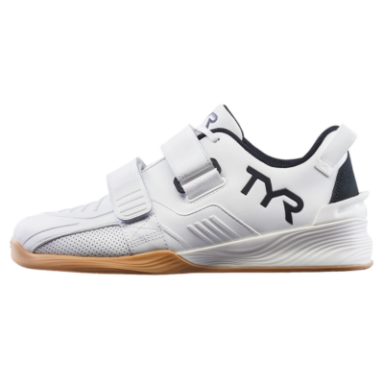







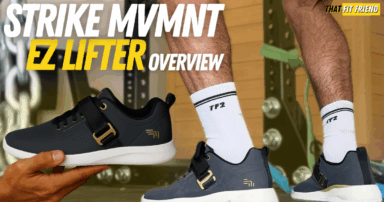
Add a Comment